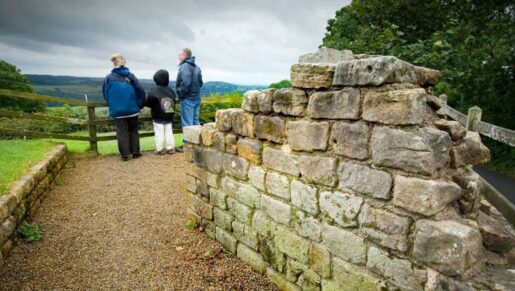
Glossary and Abbreviations
Start Exploring
Antonine Wall – Roman Empire frontier system running across central Scotland from Firth of Forth to Clyde Estuary, constructed c AD 142 on the orders of Emperor Antoninus Pius; inscribed as part of the Frontiers of the Roman Empire World Heritage Site, July 2008.
AONB – Now known as National Landscapes, formerly Areas of Outstanding Natural Beauty, a form of protected landscape designated by Natural England.
Berm – area of level ground between north face of Hadrian’s Wall and the ditch.
Bratislava Group – a panel of international experts that advises the Inter-governmental Committee of the FRE (q.v.) on strategic issues in archaeology and management.
Buffer Zone – area surrounding the scheduled area of Hadrian’s Wall World Heritage Site as a means of protecting the landscape setting of the Site.
Central sector – that section of the World Heritage Site between Greenhead and Chollerford.
Clayton Wall – a stretch of the Wall between Steel Rigg and Housesteads consolidated and partly rebuilt in the mid-19th century under the direction of antiquarian John Clayton.
Corridor – an informal term used to describe the area roughly ten miles either side of the Wall which is most directly impacted by the presence of the World Heritage Site.
Curtain wall – a wall which does not have any structural loading; here used to refer to the linear stone wall itself.
DCMS (the Department for Digital Culture, Media and Sport) – United Kingdom government department with overall responsibility to UNESCO for the management of World Heritage Sites.
Defra (the Department of the Environment, Food and Rural Affairs) – United Kingdom government department, which sponsors Natural England.
Delivery Groups – sub-groups of the Partnership Board established to deliver specific aspects of the implementation of the Management Plan.
DLUHC (the Department for Levelling Up, Housing and Communities) – United Kingdom government department responsible for determining national planning policy and for the preparation of associated Planning Policy Guidance and related legislation.
English Heritage – a charity established in 2015 to manage the national collection of properties in state care. (A non-departmental public body of the same name, set up in 1984, carried out this duty and was also the government’s principal advisor on the historic environment until 2015.)
Environmental Stewardship Schemes – generic term for a range of schemes administered by Natural England, which provide grant payments to land managers to manage land to protect the natural and historic environment.
Equality Act 2010 – primary legislation which provides the framework of protection against direct and indirect discrimination, harassment and victimisation in services and public functions, education, associations and transport.
Frontiers of the Roman Empire (FRE) World Heritage Site – a collective designation by UNESCO established in 2005. A phased transnational site, which currently includes the German Limes, the Antonine Wall, and the Hadrian’s Wall World Heritage Sites.
Generic Consents – consents provided by Historic England to allow specific forms of land management activity to be conducted on Scheduled Monuments without individual approvals.
Geophysical survey – process of identifying below-surface features, including archaeological ones, without excavation.
German Limes (Obergermanisch Raetische Limes) – the Roman frontier system developed under the Emperors Hadrian and Antoninus Pius between the Rhine and the Danube in south-western Germany, inscribed as a World Heritage Site in 2005.
GIS (Geographic Information System) – process of recording, displaying and managing all forms of geographically referenced information.
GPDO (General Permitted Development Order) – legal instrument exempting certain types of development from having to seek planning permission.
(English Heritage) Guardianship – arrangement by which a site is maintained and managed by English Heritage on behalf of the UK government in perpetuity.
Hadrian’s Cycleway – National Cycle Route 72, opened in 2006, running across Hadrian’s Wall WHS from Ravenglass to South Shields.
Hadrian’s Wall – the frontier system originally built on the orders of Emperor Hadrian, including its subsequent Roman modifications; also used to refer to the linear barrier itself.
Hadrian’s Wall Country – brand name through which the World Heritage Site and its corridor are promoted.
Hadrian’s Wall Learning and Education Forum (HWLEF) – the group responsible for developing the Continuing Learning Strategy for Hadrian’s Wall.
Hadrian’s Wall Heritage Limited (HWHL) – body (subsequently a charity) established from 2006 to 2014 to coordinate the management, promotion and development of the World Heritage Site.
Hadrian’s Wall Management Plan Committee (MPC) – the former iteration of the supervisory body which, until 2015, represented interests in the World Heritage Site and which oversaw the preparation and delivery of the Management Plan. It has been replaced by the Partnership Board.
Hadrian’s Wall Path National Trail – one of 15 nationally designated long distance Public Rights of Way, opened in 2003.
Hadrian’s Wall Tourism Partnership (HWTP) – operational from 1995 to 2006 to coordinate promotion of the World Heritage Site.
Hadrian’s Wall Transport Strategy – report produced in 1999 commissioned by English Heritage.
Hadrian’s Wall World Heritage Site (Hadrian’s Wall WHS) – that area of scheduled monuments specifically included in the Nomination Document for Hadrian’s Wall.
Hexham Group – the informal name for the Management Group of the FRE (q.v.), which shares best practice at an operational level.
Higher Level (Stewardship) Scheme – see Environmental Stewardship Schemes.
Historic England – the body set up under the Historic Buildings and Monuments Commission for England to act as the government’s principal advisor on the historic environment.
Historic Landscape Characterisation (HLC) – method of recording and describing rural landscapes.
ICOMOS (International Council on Monuments and Sites) – international non-governmental organisation of professionals, dedicated to the conservation of the world’s historic monuments and sites.
Inscription – formal registration of a World Heritage Site by UNESCO.
In situ – in the original location.
Interpretation Framework – proposed mechanism and set of principles which will guide development of interpretation across the World Heritage Site.
Limes – Latin term for frontiers; see also German Limes.
Local Development Framework (LDF) – statutory document produced by Local Planning Authorities setting out local development policies; replaces previous Local Development Plans.
Local Planning Authority (LPA) – local government bodies with responsibility for managing planning systems; include Borough, County, District and Metropolitan Councils and National Park Authorities.
The Major Study – report produced in 2004 for the North West Regional Development Agency and ONE NorthEast into the future management of the Hadrian’s Wall World Heritage Site as a driver of economic development.
Management Plan – management framework or system required by UNESCO, of all World Heritage Sites.
Milecastle – a fortified gateway through the Wall, set at a distance of approximately one Roman mile apart; milecastles are referred to by their sequential numbers from east to west along the Wall.
Milefortlet – freestanding structures, similar to milecastles, built along the Cumbrian coast from Bowness to Maryport.
Military Road – B6318 public highway which runs from Heddon-on-the-Wall to Greenhead, built in the 1750s; between Heddon-on-the-Wall and Sewingshields it runs almost continuously directly over the Wall itself.
Military Way – a Roman metalled road running generally between the southern face of the Wall and the Vallum.
Military zone – the area between the Wall and the Vallum.
Mosses – raised (usually lowland) bogs filling hollows created by glacial erosion.
NNPA – Northumberland National Park Authority.
Nomination Document – the submission document provided by United Kingdom government to UNESCO for the inscription of Hadrian’s Wall as a World Heritage Site.
Operational Guidelines – guidelines for the implementation of the 1972 UNESCO World Heritage Convention, which set forth the procedure for the inscription, protection and conservation of World Heritage Sites.
Outstanding Universal Value (OUV) – formal statement endorsed by the World Heritage Committee setting out the justification for inscription as a World Heritage Site.
Periodic Report – monitoring reports required by UNESCO for each World Heritage Site.
Pilgrimage, the Hadrian’s Wall – decennial conference that reviews developments in the archaeological understanding of Hadrian’s Wall.
Poaching – churning up of ground by livestock.
Portable Antiquities Scheme – voluntary scheme run by DCMS to record archaeological objects found by the public which fall outside the Treasure Act 1996, to raise awareness of the educational value of archaeological finds in their context, and to facilitate associated research.
Research Framework – a framework created for the review and implementation of academic research about the World Heritage Site. Specifically, Frontiers of Knowledge: a Research Framework for Hadrian’s Wall, M Symonds and D Mason (eds) 2009, Durham.
Scheduled Monument (SM) – a site of national significance as defined in the Ancient Monuments and Archaeological Areas Act, 1979.
Scheduling – process by which sites and monuments are registered as Scheduled Monuments.
(The) Site – Hadrian’s Wall World Heritage Site.
Shielings – upland shelters used by late medieval farmers during summer grazing.
SSSI (Site of Special Scientific Interest) – a form of protected landscape designated by Natural England,
(The) Stanegate – the Anglo-Saxon name for the pre-Hadrianic Roman road that ran between Corbridge and Carlisle.
State Parties – term used by UNESCO to refer to nations that have signed and ratified the 1972 World Heritage Convention.
Stewardship Schemes – see Environmental Stewardship Schemes.
Supplementary Planning Documents (SPD) – documents prepared by Local Planning Authorities to provide more detailed policies in support of Local Development Frameworks.
Turret – small towers equally spaced between milecastles at a distance of approximately one third of a Roman mile; turrets are numbered a and b within each Wall-mile
UNESCO (United Nations Educational, Scientific and Cultural Organisation) – agency of the United Nations; aims to contribute to peace and security by promoting international collaboration through education, science and culture; responsible for implementation of the World Heritage Convention, and the inscription and regulation of World Heritage Sites
Vallum – large ditch with linear mounds on either side, constructed to the south of (and approximately parallel with) the Wall.
Vicus – civilian settlement outside a Roman fort.
VisitBritain – United Kingdom national tourism agency responsible for marketing the United Kingdom worldwide and for developing England’s tourism economy. Cf. also VisitEngland.
Wall-mile – reference number to identify sections of the Wall between (numbered) milecastles.
Whin Sill – dolerite outcrops, which offered defensive advantage to the Wall between Sewingshields and Greenhead.
WHS – World Heritage Site
World Heritage Committee – elected committee of nations that are parties to the World Heritage Convention: its tasks are to identify nominated cultural and natural properties of Outstanding Universal Value (OUV) to be protected under the Convention, and to inscribe them on the World Heritage List; decide if properties on the list should be included on the List of World Heritage in Danger; and determine how and under what conditions the World Heritage Fund can be used to assist countries in the protection of their World Heritage Sites.
World Heritage Convention – international treaty on the Protection of the World Cultural and Natural Heritage, adopted by UNESCO in 1972.





